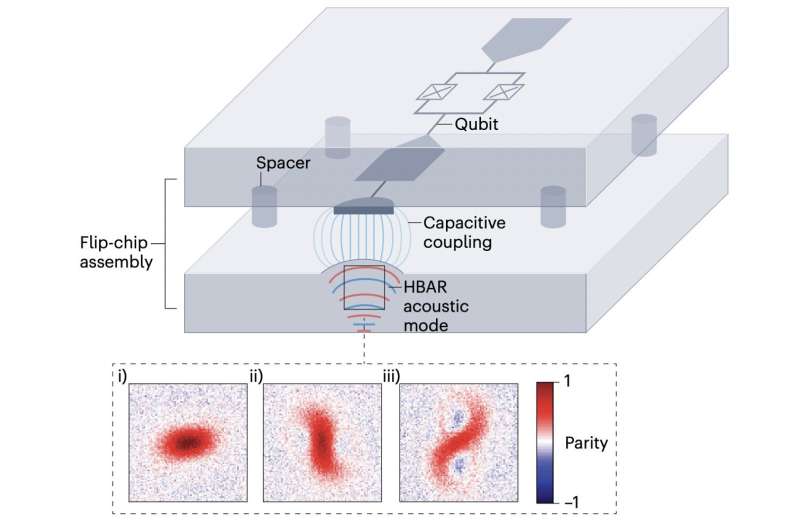
Schematic of the nonclassical mechanical states of a resonator-qubit combination. A transmon qubit couples capacitively to the acoustic mechanical modes of a separate sapphire plate, one of which is represented by a series of blue and red antinodes. From this interaction the nonclassical mechanical states arise. Three vignettes reproduce the Wigner functions of i) a squeezed vibrational state, ii) a non-Gaussian vibrational state, and iii) a non-Gaussian vibrational state with large negative values of the Wigner function, characteristic of strong nonclassicality. Credit: Adapted from reference 7, Springer Nature Ltd. Thumbnails reproduced from reference 1, Springer Nature Ltd.
Mechanical systems are particularly suited to realizing applications such as quantum information processing, quantum sensing, and bosonic quantum simulation. The effective use of these systems for these applications, however, relies on the ability to manipulate them in unique ways, including by “squeezing” their states and introducing nonlinear effects into the quantum regime.
A research team from ETH Zurich led by Dr. Matteo Fadel recently presented a new approach to achieve quantum compression in a nonlinear mechanical oscillator. This approach, described in a paper published in Physics of naturecould have interesting implications for the development of quantum metrology and sensing technologies.
“Our initial goal was to prepare a squeezed mechanical state, namely a state of quantum motion with reduced quantum fluctuations along a phase-space direction,” Fadel told Phys.org. “Such states are important for quantum sensing and simulation applications. They are one of the gates in the set of universal gates for quantum computing with continuous variable systems, i.e. mechanical degrees of freedom, electromagnetic fields, etc., as opposed to qubits which are discrete variable systems.”
As they performed their experiments and tried to obtain an increasing amount of compression, Fadel and his colleagues realized that beyond a certain threshold, the mechanical state became more than just narrower (i.e. more compressed) and more elongated. Furthermore, they found that the state began to twist/rotate on itself, following an “S” or even “8” shaped pattern.
“We did not expect this, because the preparation of non-Gaussian states requires significant nonlinearities in the mechanical oscillator, so we were quite surprised, but of course also excited,” Fadel says.
“Typical mechanical nonlinearities are extremely small, and typical couplings between mechanical oscillators and light/microwave fields are also linear. However, it was easy to realize that in our device the resonator inherited some of the nonlinearity of the qubit to which it was coupled.”
The researchers found that the nonlinearities inherited from the resonator were quite strong, which gave rise to the fascinating effect they observed. In their recent paper, they presented this new approach to achieve quantum squeezing in this nonlinear mechanical system.
The system used in the team’s experiments consists of a superconducting qubit coupled to a mechanical resonator via a disk made of piezoelectric material. The coupling between these two systems results in the effective nonlinearity of the resonator.
“When two-tone training is applied to the system at the correct frequencies, f1+f2=2*fm (where f1 and F2 are the two-tone training frequencies and fm the frequency of the mechanical mode), a parametric process takes place: two microwave photons at frequencies f1 and F2 disks are converted into a pair of phonons at frequency fm mechanics,” Fadel said.
“It’s very similar to a parametric conversion process in optics, where light fields are sent to a nonlinear crystal that generates compression in a way similar to what I described.”
The new mechanical compression approach introduced by this team of researchers could soon open new perspectives for the research and development of quantum devices. In their experiments, Fadel and his colleagues also used their approach to demonstrate the preparation of non-Gaussian motion states and confirmed that their mechanical resonator exhibits tunable nonlinearity.
“Notably, the nonlinearity we observed in our resonator is tunable, as it depends on the difference between the frequencies of the qubit and the resonator, which can be controlled in the experiment,” Fadel said.
“The realization of squeezed states has important applications for quantum metrology and for quantum information processing using continuous variables. Non-Gaussian states can also be used as a resource for quantum information tasks and for fundamental research in quantum mechanics.”
In future studies, Fadel hopes to further investigate the possibility of realizing a quantum mechanical simulator based on the approach presented in this recent paper. Specifically, this simulator could exploit the ability to independently address and control dozens of bosonic modes in the team’s acoustic resonators.
“Our devices could also find interesting applications in quantum force detection, gravitational waves, and even in fundamental physics tests,” Fadel added. “Recently, we showed in a follow-up work that mechanical nonlinearity can be so strong that it allows us to realize a mechanical qubit.”
More information:
Stefano Marti et al, Quantum compression in a nonlinear mechanical oscillator, Physics of nature (2024). DOI: 10.1038/s41567-024-02545-6
© 2024 Science X Network
Quote:A new approach to achieve quantum mechanical squeezing (2024, July 8) retrieved July 9, 2024 from https://phys.org/news/2024-07-approach-quantum-mechanical.html
This document is subject to copyright. Apart from any fair dealing for the purpose of private study or research, no part may be reproduced without written permission. The content is provided for informational purposes only.